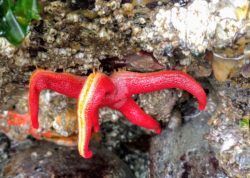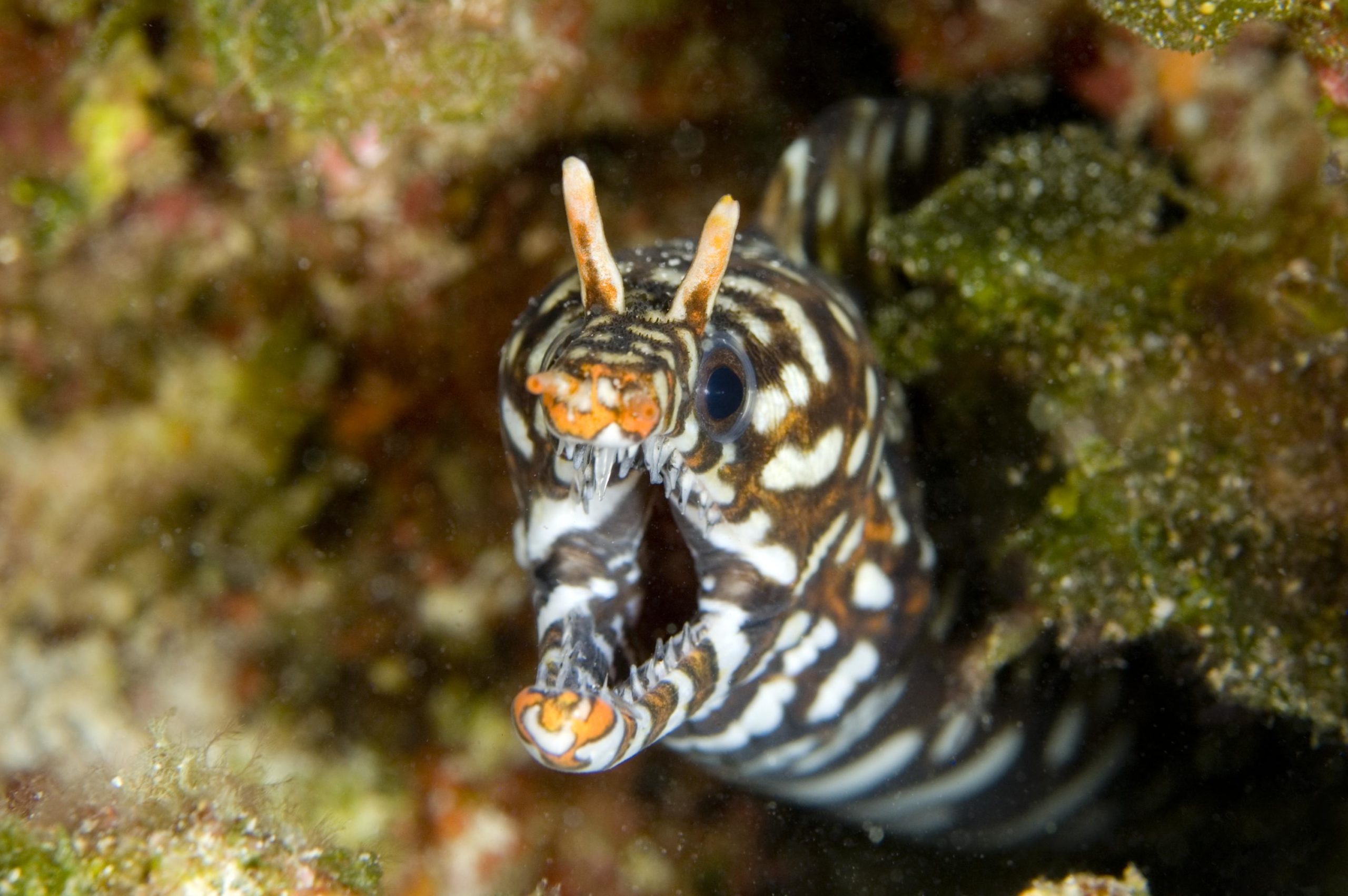
Spooky Sea Creatures to Get You in the Halloween Spirit
It’s spooky season, which is the perfect opportunity to highlight and appreciate some of the ocean’s spookiest – but still ecologically important – species. Take a look, if you dare!
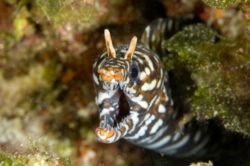
Dragon Moray Eel in Papahānaumokuākea Marine National Monument. Photo: Greg McFall/NOAA
The Dragon Moray Eel (Enchelycore pardalis) has dragon-like “horns” above its eyes, which are actually nasal tubes that help them find food. Its curved, powerful jaw is full of sharp, fang-like teeth and it can’t fully close its mouth, giving it an intimidating appearance. The dragon moray eel can reach lengths of three feet or more. Its slender body is well adapted for hunting within reef crevices and its skin is covered in a slime layer that wards off infection and parasites. Like other species of eel, the dragon moray eel lives in small caves and openings in coral reefs where it waits patiently until an unsuspecting fish or octopus swims by; to feed it ambushes its prey and swallows it whole, immediately returning to its hiding place. The dragon moray eel’s brown and yellow skin markings make it less noticeable at night, when it is the most successful at hunting.
The dragon moray eel is an important predator on Hawaiian Reefs, removing sick or otherwise vulnerable prey from the environment and keeping populations in balance. Its range includes Hawaiian Islands Humpback Whale National Marine Sanctuary and Papahanaumokuakea Marine National Monument in the Northwestern Hawaiian Islands. Despite its ferocious appearance, the dragon moray eel is generally docile and harmless to divers, though it will defend its shelter when it feels threatened.

Scorpionfish spotted in the deep waters of Channel Islands National Marine Sanctuary by researchers aboard the E/V Nautilus. Photo: OET/NOAA
The Scorpionfish (Scorpaenidae sp.) is a famous marine ambush predator. Its skin allows it to blend in with their surroundings in a reef or near the seafloor and its speed means its prey don’t stand a chance. This fish is a nocturnal predator and is one of the most poisonous animals in the ocean. To camouflage with corals, grasses, and the rocky and sandy ocean floor, it adapted a skin covered in feathery fins and elaborate brown and white patterned markings. It is covered in venomous spines that are lethal to other animals and painful for humans if accidentally stung. You can look but definitely don’t touch! This fish’s wide mouth allows it to vacuum their prey whole in a mere instant – well before the victim knows what is happening. The scorpionfish prefers temperate waters and rocky reef areas for their habitat, including in the national marine sanctuaries on America’s west coast.
The Blood Star (Henricia leviuscula) is the most brightly colored sea star in the intertidal zone, most often found on or under rocks. It feeds on microscopic organisms and organic particles that it captures in the mucus that lines the bottom of each of its five arms. Once stuck, cilia – hair-like structures – move the food toward its mouth at the center of its body. Sometimes, the blood star even expels its entire stomach to collect food as the animal moves along rocks (a gross but efficient feeding strategy). The blood star lacks a heart, eyes, or centralized brain, and it doesn’t have sensory organs beyond red eyespots at the end of each arm that it uses to tell the difference between light and dark environments. The blood star is common in the Pacific Ocean, ranging from Alaska down to Baja California in Mexico, a range that includes Olympic Coast National Marine Sanctuary and others along the California coast.
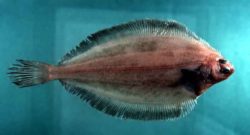
Witch Flounder. Photo: NOAA
The Witch Flounder (Glyptocephalus cynoglossus) is a right-eyed species of flounder and is commercially fished. Born with eyes on both sides of its head, the witch flounder flattens as it grows, and the left eye moves over to the right side of its head. Talk about creepy! The side with both eyes becomes the animal’s top (dorsal) side, which is gray brown in color, and the bottom (ventral) side is white and covered in dark spots. The witch flounder eats polychaete worms and bottom-dwelling invertebrates, and it lives in the eastern and western regions of the North Atlantic Ocean, including in and near Stellwagen Bank National Marine Sanctuary. The witch flounder is docile, harmless, and can’t perform any magic spells. Unfortunately, this species is overfished in many parts of its range.
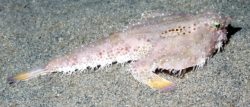
Batfish. Photo: Andrew David, NOAA/NMFS/SEFSC Panama City; Lance Horn, UNCW/NURC – Phantom II ROV operator
The Deep-Sea Batfish (Ogcocephalus sp.) is a “walking” fish that crawls on the sea floor. They are collectively known as batfishes but are not actually related to true batfishes at all. Instead, they are a member of the anglerfish order. Deep-sea batfish consist of about 60 species in the family Ogcocephalidae including the Red-lipped batfish, shortnose batfish, and longnose batfish. Batfishes are poor swimmers so it makes sense that they adapted “frog-like” legs. These legs are actually pelvic and pectoral fins which are perfect for moving along the ocean bottom. When a predator approaches, batfishes will quickly scurry in the opposite direction or bury themselves into the sand. Guess, they’re not too scary after all.

